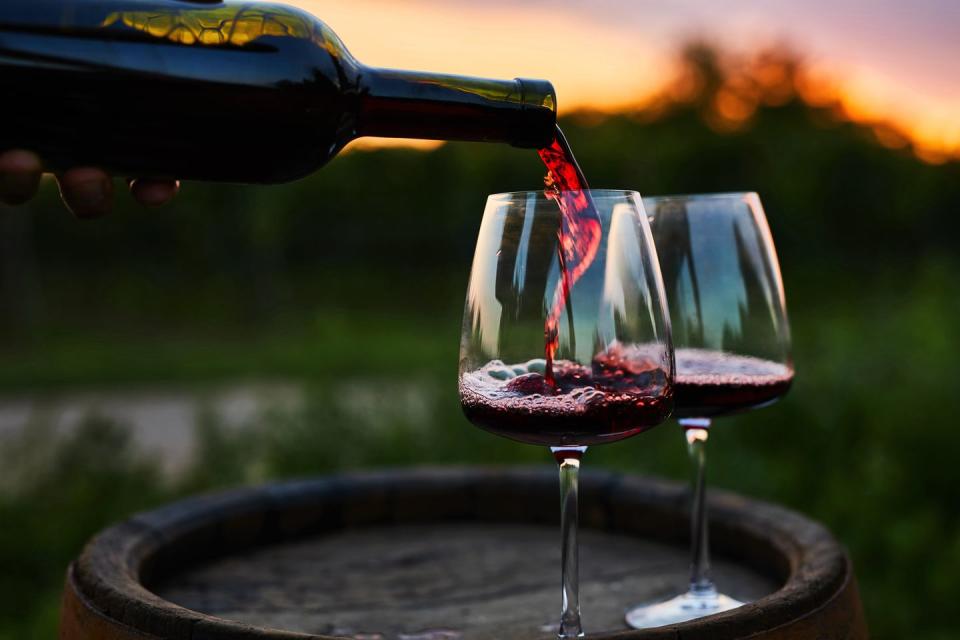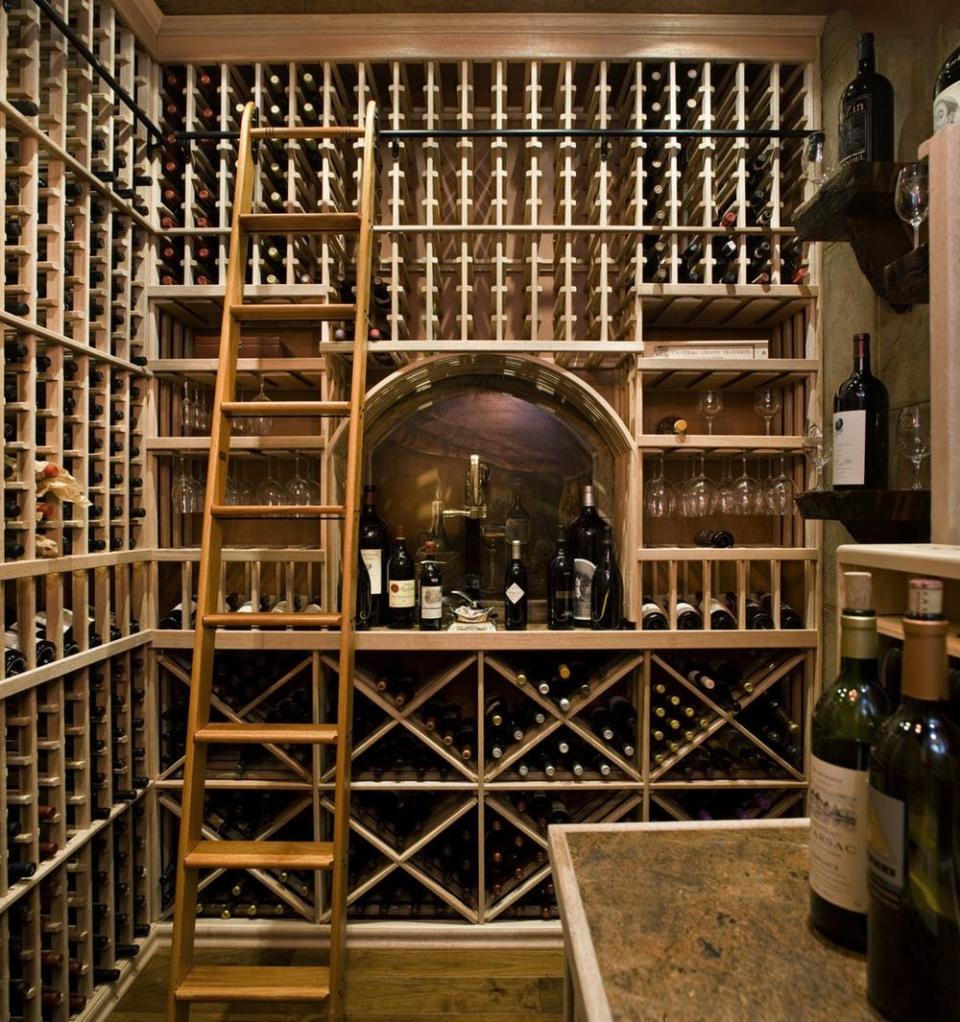Here's How Long You Should Save a Bottle of Wine, According to Sommeliers

It’s not just vintage jewelry and home decor that have reputations related to gaining value with age. In the wine world, that association is so common that there’s even an old adage about it: “It’s aging like a fine wine.”
Contrary to popular belief, not all wines—in fact, not many wines—age gracefully.
“Some wines have the magical ability to improve with age, which is practically non-existent not only in the world of beverages, but in nature. Outside of Morgan Freeman and Salma Hayek, most organic matter tends to slow down and become a little less pretty over time. Wine is no exception,” admits Sam Tuttle, the wine director at Oak Park in Des Moines, Iowa (where he oversees a 7,000-bottle wine cellar).
Read on as sommeliers spill about what wines age well, how to determine the ideal time to drink (or sell) wine that you do choose to age and how to store wine properly whether you plan to drink it next week or next decade.
Why Don’t All Wines Age Well?

Go ahead, uncork that bottle from your wine collection that you’ve been saving for a special occasion. On average, only one bottle in every 100 available is actually meant to be saved for more than 12 months, confirms James Couty, food and beverage manager at Pendry Chicago and Chateau Carbide in Chicago, Illinois.
“Drinking cellared wine is often romanticized in television and movies, but in modern times, the reality is that 99 percent of wines are meant to be enjoyed within a year of purchase,” Couty says.
The vast majority of wines are meant to be consumed young and fresh, when they’re showing their most fruity and exciting qualities, Tuttle reveals.
Age-worthy wines do exist, but the best wineries usually age these themselves (in a barrel, in the bottle, or a combination of both) before releasing them. Since the producers go to the expense and effort of storing them and overseeing them, you’ll likely see these wines marketed as age-worthy or old wines.
“The majority of wineries won't release a wine if it isn't ready to be enjoyed,” explains Amy Mundwiler, the national wine director of Maple Hospitality Group, a Chicago-based hospitality brand that includes Maple & Ash, Monarch and Kessaku. “That said, there are of course wines with recommended drinking windows that start a few years after they're released. These are usually sought-after wines that collectors can't wait to get their hands on.”
The Qualities of “Ageable” Wines

So what makes a wine part of the age-worthy 1 percent?
“Honestly, price is a good indicator if you’re just starting out. I can't think of many wines under $25 retail that have a lot of aging potential; although they are out there,” Tuttle says. “I also can't think of many that aren’t age-worthy at $100 and above. On the other side of the coin, I can't think of many $1,000 bottles that are immediately ready to drink upon release.”
So $100 or more is a sign that a wine may have aging potential. But just as the price on a wine menu at a restaurant can only tell you so much, it’s not all about money.
Beyond that, knowing which grapes and regions are famous for checking one or more of the following boxes will steer you well. Without these structural elements, wines tend to slowly go downhill and should be consumed “young,” or within the next year or two.
Tannins, which can come from oak barrels or the grape skins red wines are fermented alongside. Wines rich in tannins “contain compounds that help slow the aging process and bind together over time, becoming rounder and more pleasant,” according to Tuttle.
Acidity: Just like a pickle can be preserved longer than a piece of fresh produce, acidity in wine aids in aging. “Acid preserves wine and helps it live a long happy life,” says Bryan Lipa, founder and owner of Evolve Wine Group in Napa, California. “The reputable producers of the greatest wine regions of the world pick their grapes at the exact point when the acid to fruit ratio is right where they want it.”
Sugar: Sweet wines can age for decades because of the high sugar content, Tuttle adds.
Overall, a lot of structure is what can help to make a wine cellar-worthy.
“For example, wines with searing acid or astringent tannins tend to age well because that structure has time to mellow and further integrate into the wine without disappearing, so the wine remains balanced as it ages,” says Katherine Sturgill, certified sommelier, wine director and general manager at Daisies in Chicago, Illinois.
It’s also important to consider whether the region or producer has a reputation for releasing age-worthy wines as well as the grape(s) in question. Lipa shares that you may be able to find an age-worthy wine from:
Bordeaux (cabernet sauvignon, merlot, sauvignon blanc and sémillon for Sauternes)
Burgundy (pinot noir and chardonnay)
Piedmont (nebbiolo)
Tuscany (sangiovese)
Rioja (tempranillo)
Mosel (riesling)
Napa (cabernet sauvignon)
(Keep in mind that this is a summary rather than an exhaustive list.)
And just like the best laid travel plans can get diverted by a storm, even the most age-worthy grapes can get thrown off by extreme weather, so consider the conditions, too.
“Mother Nature always plays a role in this,” Lipa says, “which is why vintage knowledge is important when picking a wine to put in the back of the cellar to gain a decade or more of age. Great vintages usually lead to great ageability.”
How to Know When to Open a Bottle of Wine

Similar to what makes a wine sustainable or natural, the answer to “when should I drink a particular wine?” is complicated. This will vary based on your personal preference, the weather throughout the year the grapes were grown, the exact amount of those aforementioned structural elements in the wine and even how you’re storing it.
Your best bet is to either search for the wine on the producers website, then look for the “drink through” date. If you don’t see that, feel free to reach out to the producer for their advice.
“It’s great to get advice from the people who drink the wine constantly,” Tuttle advises.
Follow these general “when to open” guidelines:
Most white wines are typically at their prime within 5 years of bottling
Most thin-skinned red grapes are ideal to consume within 5 to 7 years
Most thicker-skinned red grapes are best enjoyed with 5 to 10 years of age
Even the most cellar-worthy wines are not recommended to be aged beyond 20 years
Couty verifies that as a general rule, if a wine is released, it's meant to be consumed relatively soon.
“Of course, the best of the best can stretch these aging recommendations dramatically,” Lipa says.
If you happen to have multiples of the same bottle, Sturgill recommends tasting as you go so you can experience the wine as it ages and see how it changes over time and take note of what you enjoy (and don’t). This does present a risk that you can age the wine “past its prime” in your personal opinion.
Home style and fashion preferences are so personal, as are your particular wine wishes. If you prefer fresh fruit over spice flavors, grab that corkscrew sooner rather than later. And if you want bright bubbles in your Champagne, enjoy it younger rather than older, Mundwiler suggests.
How to Buy and Store Age-Worthy Wines

If you're looking for a wine to age and add to your collection, it's best to consult your local wine shop so you have a higher chance of making a sound investment. While it can be challenging to dig up that 1-in-100 bottle, it is possible—and some delight in the hunt.
“Finding a bottle that is 50 years old still hanging on with incredible complexity, I think, is the pinnacle of collecting and aging wines, “Lipa says.
If you think you may have come across an age-worthy wine, Lisa suggests buying a six-pack if possible so you can try it at different ages.
Then to ensure you’re giving the wine its best chance to shine when you do pop it open, it’s vital to store it properly. Keep the wine in a cool, dark place away from vibrations and in an environment with a consistent temperature as close to 55 degrees F as possible. (A wine fridge is a stellar spot.)
You Might Also Like

